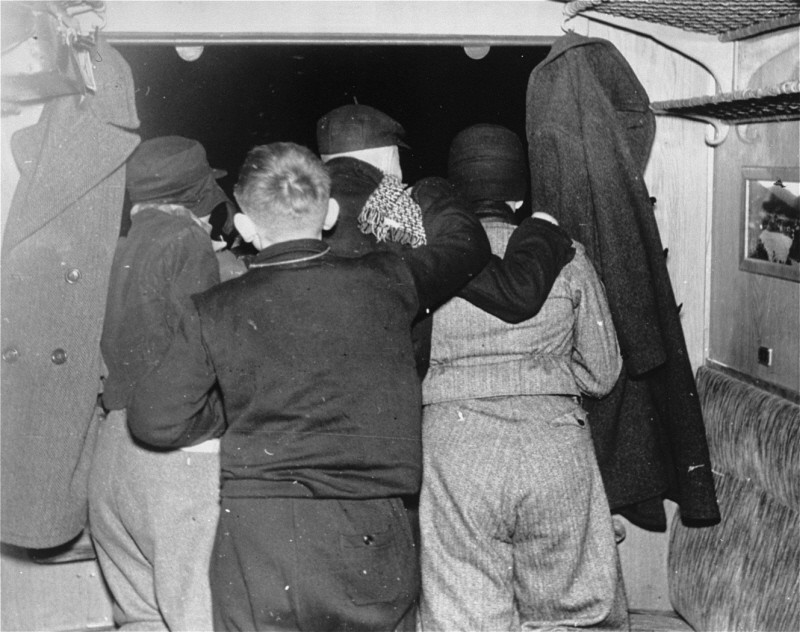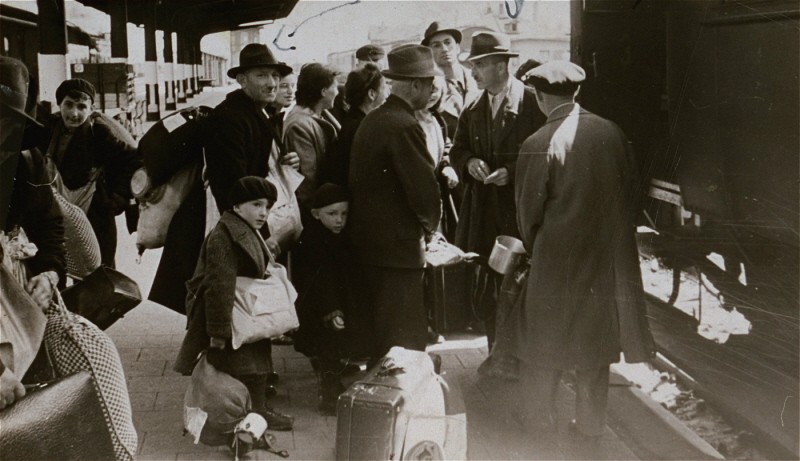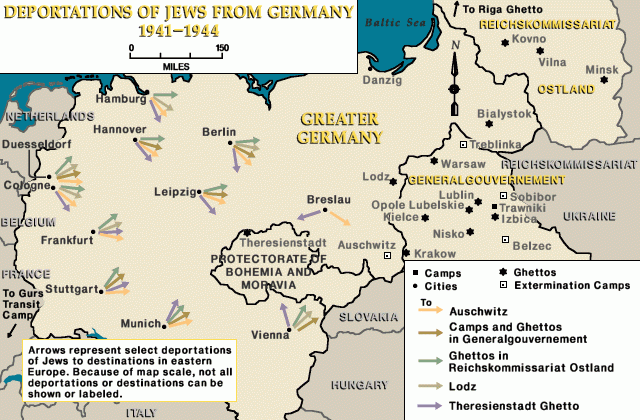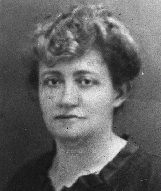
German Jews during the Holocaust
The onset of World War II brought accelerated persecution and deportation and later, mass murder, to the Jews of Germany. In all, the Germans and their collaborators killed between 160,000 and 180,000 German Jews in the Holocaust, including most of those Jews deported out of Germany.
Key Facts
-
1
By the start of World War II in September of 1939, over half of German Jews had relocated to other countries. Approximately 304,000 Jews, emigrated during the first six years of the Nazi dictatorship.
-
2
Between 1939 and 1941, Jews were systematically deprived of their property and their ability to work. By early 1939, only about 16 percent of Jewish breadwinners had steady employment of any kind. Life in Germany became increasingly difficult as a result of many restrictive laws.
-
3
In 1941, Nazi anti-Jewish policy became more radical. Jews were marked with a Star of David badge. The first deportations of Jews from Germany to ghettos and camps in the east began.
1933–39

In January 1933, some 522,000 Jews by religious definition lived in Germany. Over half of these individuals, approximately 304,000 Jews, emigrated during the first six years of the Nazi dictatorship, leaving only approximately 214,000 Jews in Germany proper (1937 borders) on the eve of World War II.
In the years between 1933 and 1939, the Nazi regime had brought radical and daunting social, economic, and communal change to the German Jewish community. Six years of Nazi-sponsored legislation had marginalized and disenfranchised Germany's Jewish citizenry and had expelled Jews from the professions and from commercial life. By early 1939, only about 16 percent of Jewish breadwinners had steady employment of any kind. Thousands of Jews remained interned in concentration camps following the mass arrests in the aftermath of Kristallnacht (Night of the Broken Glass) in November 1938.
World War II
Yet the most drastic changes for the German Jewish community came with World War II in Europe. In the early war years, the newly transformed Reich Association of Jews in Germany (Reichsvereinigung der Juden in Deutschland), led by prominent Jewish theologian Leo Baeck but subject to the demands of Nazi German authorities, worked to organize further Jewish emigration, to support Jewish schools and self-help organizations, and to help the German Jewish community contend with an ever-growing mass of discriminatory legislation.
Following the outbreak of war on September 1, 1939, the government imposed new restrictions on Jews remaining in Germany. One of the first wartime ordinances imposed a strict curfew on Jewish individuals and prohibited Jews from entering designated areas in many German cities. Once a general food rationing began, Jews received reduced rations; further decrees limited the time periods in which Jews could purchase food and other supplies and restricted access to certain stores, with the result that Jewish households often faced shortages of the most basic essentials.
German authorities also demanded that Jews relinquish property “essential to the war effort” such as radios, cameras, bicycles, electrical appliances, and other valuables, to local officials. In September 1941, a decree prohibited Jews from using public transportation. In the same month came the notorious edict requiring Jews over the age of six to wear the yellow Jewish Star (Magen David) on their outermost garment. While ghettos were generally not established in Germany, strict residence regulations forced Jews to live in designated areas of German cities, concentrating them in “Jewish houses” (“Judenhäuser”). German authorities issued ordinances requiring Jews fit for work to perform compulsory forced labor.

In early 1943, as German authorities implemented the last major deportations of German Jews to Theresienstadt or Auschwitz, German justice authorities enacted a mass of laws and ordinances legitimizing the Reich's seizure of their remaining property and regulating its distribution among the German population. The persecution of Jews by legal decree ended with a July 1943 ordinance removing Jews entirely from the protection of German law and placing them under the direct jurisdiction of the Reich Security Main Office (Reichssicherheitshauptamt-RSHA).
Deportations

The first deportations of Jews from the Reich—Jews from areas recently annexed by Germany—began in October 1939 as part of the Nisko, or Lublin, Plan. This deportation strategy envisioned a Jewish “reservation” in the Lublin District of the General Government (that part of German-occupied Poland not directly annexed to the Reich). Adolf Eichmann, the German RSHA official who would later organize the deportation of so many of Europe's Jewish communities to ghettos and killing centers, coordinated the transfer of some 3,500 Jews from Moravia in the former Czechoslovakia, from Katowice (then Kattowitz) in German-annexed Silesia, and from the Austrian capital, Vienna, to Nisko on the San River. Although problems with the deportation effort and a change in German policy put an end to these deportations, Eichmann's superiors in the RSHA were sufficiently satisfied with his initiative to ensure that he would play a role in future deportation proceedings.
In addition, RSHA officials coordinated the deportation of approximately 100,000 Jews from German-annexed Polish territory (the so-called province of Danzig-West Prussia, District Wartheland, and East Upper Silesia) into the General Government in the autumn and winter of 1939–1940. In October 1940, Gauleiter Josef Bürckel ordered the expulsion of nearly 7,000 Jews from Baden and the Saarpfalz in southwestern Germany to areas of unoccupied France in a second deportation of German Jews. French authorities quickly absorbed most of these German Jews in the Gurs internment camp in the Pyrenees of southwestern France.
Upon Hitler's authorization, German authorities began systematic deportations of Jews from Germany in October 1941, even before the SS and police established killing centers (“extermination camps”) in German-controlled Poland. Pursuant to the Eleventh Decree of Germany's Reich Citizenship Law (November 1941), German Jews “deported to the East” suffered automatic confiscation of their property upon crossing the Reich frontier.

Between October and December 1941, German authorities deported around 42,000 Jews from the so-called Greater German Reich—including Austria and the annexed Czech lands of Bohemia and Moravia—virtually all to ghettos in Lodz, Minsk, Kovno (Kaunas, Kovne), and Riga. German Jews sent to Lodz in 1941 and to Warsaw, the Izbica and Piaski transit ghettos and other locations in the Generalgouvernement in the first half of 1942 numbered among those deported together with Polish Jews to the killing centers of Chelmno (Kulmhof), Treblinka, and Belzec.

German authorities deported more than 50,000 Jews from the so-called Greater German Reich to ghettos in the Baltic states and Belorussia (today Belarus) between early November 1941 and late October 1942. There the SS and police shot the overwhelming majority of them. After selecting a small minority to survive temporarily for exploitation as forced laborers, the SS and police interned them in special German sections of the Baltic and Belorussian ghettos, segregated from those few local Jews whose survival the SS and police had permitted, generally to exploit special occupational skills.
Such “German ghettos” within a larger ghetto framework existed notably in Riga and in Minsk. SS and police officials killed most of these German Jews when they liquidated the ghettos in 1943. After late October 1942, the German authorities deported the majority of Jews remaining in Germany directly to the killing center at Auschwitz-Birkenau or to Theresienstadt.
German regulations initially exempted German Jewish war veterans and elderly persons over the age of sixty-five, as well as Jews living in mixed marriages (“privileged marriages”) with German “Aryans” and the offspring of those marriages from anti-Jewish measures, including deportations. In the end, German officials deported disabled and highly decorated Jewish war veterans as well as elderly or prominent Jews from so-called Greater German Reich and the German-occupied Netherlands to the Theresienstadt (Terezin) ghetto near Prague. Although the SS used the ghetto as a showcase to portray the fiction of “humane” treatment of Jews, Theresienstadt in actuality represented a way station for most Jews en route to their deportation “to the east.” The SS and police routinely relocated Jews from Theresienstadt, including German Jews, to killing centers and killing sites in German-occupied Poland, Belorussia, and the Baltic States. More than 30,000 died in the Theresienstadt ghetto itself, mostly from starvation, illness, or maltreatment.
In May 1943, Nazi German authorities reported that the Reich was judenrein (“free of Jews”). By this time, mass deportations had left fewer than 20,000 Jews in Germany. Some survived because they were married to non-Jews or because race laws classified them as Mischlinge (of mixed ancestry, or part Jewish) and were thus temporarily exempt from deportation. Others, called “U-Boats” or “submarines,” lived in hiding and evaded arrest and deportation, often with the aid of non-Jewish Germans who sympathized with their plight.
In all, the Germans and their collaborators killed between 160,000 and 180,000 German Jews in the Holocaust, including most of those Jews deported out of Germany.
Critical Thinking Questions
How was the treatment of the Jews in 1939-1945 different from the previous six years?
How did wartime change the information available to the rest of Europe and the world about the situation of the Jews?

